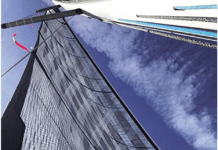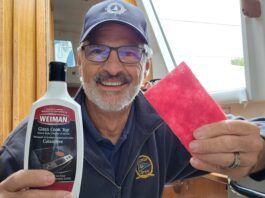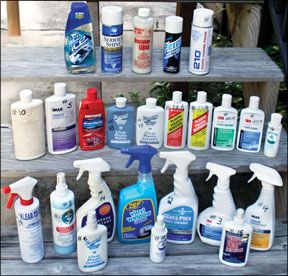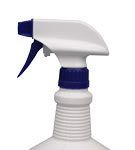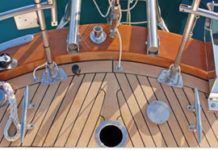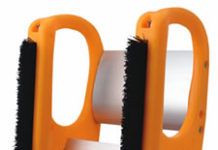Maintenance All-Stars
With the gazillion marine maintenance products out there, it’s an annual challenge to narrow the field down to just a few superior products for our Gear of the Year (GOTY) list. This year, our top maintenance picks came out of our endless antifouling-paint testing and our performance evaluation of multi-purpose cleaners—products we suspect most of you buy and use regularly.
What’s the Best Way to Clean Marine Rope?
Every spring, there are numerous online forums discussing the best rope-cleaning methods. Practical Sailors interviews with technical representatives from major rope makers Bluewater Ropes, New England Ropes, Samson Cordage, and Yale Cordage yielded uniformly conservative guidance on how to get the grit out of old lines without destroying the rope's integrity. Testers also took to the laundry room to determine the effects of detergent, wash cycles, acids, bases and solvents, fabric softeners, power washing, bleach, hot water, and heat on rope strength and stretch.
Teak: A Little Effort Goes a Long Way
Probably nothing can make or break the appearance of a fiberglass boat more quickly than the appearance of the exterior teak trim. Contrary to popular belief, teak is not a maintenance-free wood that can be safely ignored and neglected for years at a time. Though teak may not rot, it can check, warp, and look depressingly drab if not properly cared for. Although it is not immune to neglect, teak is incredibly resilient, and can be brought back to life after remarkable amounts of abuse. Therefore, there is no excuse for drab, ugly exterior teak on any boat. Unlike other woods used for exterior trim, the grey weathering of teak rarely extends very far below the surface of the wood.
Replacing Teak Decks, the DIY-er’s Way
Practical Sailor contributor and world cruiser Joe Minick details the steps he and his wife took to replace the wornout teak deck aboard their Mason 43, Southern Cross. Minick breaks down the major tasks of the three-month project and explains how they saved a lot of money by doing some of the work themselves. The article looks at the pros and cons of a do-it-yourself teak deck refit; planning and budgeting; step-by-step removal of hardware and the old deck; and the detailed installation process of the new deck.
Laid Teak Decks: Hallmark of Quality
There was a time when laid decks — teak, yellow pine, or fir — were the hallmark of a true yacht. The bare wood gave secure footing, easy maintenance, and reasonable protection from leaks. Since the advent of fiberglass, those same laid decks, almost universally of teak, have continued to represent that hallmark. However, they have become at least as much a cosmetic feature as a functional one. Teak decks, cockpit seats, cockpit sole, hatchtops, and cabin sole all lend themselves to being planked (or sheathed) in a traditional manner Almost no project can do more to "dress up" a boat than some laid decking, and it is a job the average boatowner can do himself. This article describes a simple method for laying decking, one we have used ourselves.
Sparkling Brightwork: Careful Attention to the Details
It takes practice to produce a perfect, mirror finish on varnished wood, but it is not so much a difficult task as an exacting one, where attention to detail and no short cuts are the secrets to success. Whether you are finishing new wood, refinishing old wood, or maintaining a finish in good condition, the basics are the same. Tools and materials required are sandpaper, vacuum cleaner or dusting brush, tack rag, brushes, and of course varnish and thinner If you are working from bare wood you may require stain or filler or a combination filler-stain. In cases where old wood has become discolored you will probably want to use a bleaching agent.
Chandlery: May 2011
Hydro-powered hull scrubber takes slime off but not barnacles. Bottom-scrubbing is definitely one of our least favorite boat chores. And because the warm Florida waters are the perfect nursery for hull-fouling slime and barnacles, we’re always on the lookout for products that will make the never-ending hull cleaning more bearable. That quest recently led us to try the Subscrub, a device that allows users to clean their boat hulls without hauling out or going for a…
A Rose is a Rose is a Rose, and Wood is Wood is…
For the boat owner customizing his boat, the choice of wood to use in a project can be as interesting as the design or execution of the job. Because of the overwhelming use of teak and mahogany in boatbuilding today, this opportunity to select a different wood is often overlooked.
Caring for Clear Plastics on Your Boat
There are three basic types of transparent plastics used on boats: clear vinyls, acrylics (the best known is Plexiglas), and polycarbonates (the marine standard is Lexan). Each has advantages and disadvantages, which is why most boats include some of each. Vinyl is actually plasticized, stabilized polyvinyl chloride (PVC). It’s the plastic of choice for any window or clear screen that rolls, folds, stretches or needs to be sewn to fabrics.
Professional Advice for Do It Yourself Boat Blister Repairs
Earlier this year, reader and occasional contributor Fred Hatch found himself facing a quandary common among boat owners. The topsides of his 32-foot sloop were well faded, and small blisters were beginning to show along the waterline. Would he be in for an ambitious haulout and big yard fees, or might there be other remedies?













